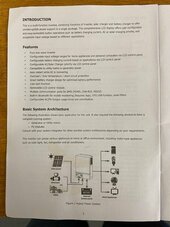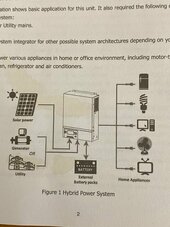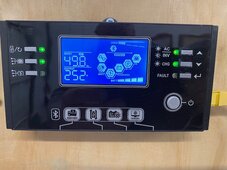Mayfield
New Member
Hello,
This is my first post so apologies if i am in the wrong place or asking a regular simple question. Having only ever used a car forum for 20 years I know how annoying it can be when a newbie asks a very basic question.
I have installed a 5kw Iconica hybrid off grid inverter with 3.6KW panel array. I am still running on some test lead acids until i splash out on some proper lithium batteries. Everything worked great out of the box. Set it going last May. It came in SBU mode doing fine over the summer whilst i was working on the property. Upon moving in I discovered the SUB mode. After reading the manual i reprogrammed to SUB. The unit voltage matched, synchronised and paralled with the utility. Being right at the side of the pole mounted rural transforner we sit at around 253 volts so i lifted the inverter voltage from 230 to 240 to lessen the voltage match movement. Having been in the property now for about 6 months I have obeserved the SUB mode doing what it says. Running in parallel using solar when available suplimented by the utilty. Or running on utility during night time.
Being from a generator background i am aware of the protection required to comply with utilty parallel. G59/G99 in UK and I believe G98 and G99 for solar grid tie.
Before I decided to fit my own system I was frustrated trying to find out about "grid tie" and "off grid" and was basically being told they are either one or the other. In my mind this is not the case. Even with SBU mode there is utilty support. I was adamant I was not going to be grid tied giving away units for next to nothing. Hence decision to go off grid falling back to utility.
So my question:
knowing that permission is required from DNO and certification of compliance to grid tie presumably some form of rocof type vector shift fast acting disconnect protection device is required. So were does that leave us with the scenario described above with an off grid hybrid inverter set in SUB mode running along with the grid.
I know it always sits in forward power to lessen the chance of any utilty export or reverse power. Upon failing the utilty feed to the inverter it momentarily drops the load to disconnect safely. I see some expensive inverters appear to have compliance approval.
How is such a system as mine viewed by the DNO.
Cheers Mike
This is my first post so apologies if i am in the wrong place or asking a regular simple question. Having only ever used a car forum for 20 years I know how annoying it can be when a newbie asks a very basic question.
I have installed a 5kw Iconica hybrid off grid inverter with 3.6KW panel array. I am still running on some test lead acids until i splash out on some proper lithium batteries. Everything worked great out of the box. Set it going last May. It came in SBU mode doing fine over the summer whilst i was working on the property. Upon moving in I discovered the SUB mode. After reading the manual i reprogrammed to SUB. The unit voltage matched, synchronised and paralled with the utility. Being right at the side of the pole mounted rural transforner we sit at around 253 volts so i lifted the inverter voltage from 230 to 240 to lessen the voltage match movement. Having been in the property now for about 6 months I have obeserved the SUB mode doing what it says. Running in parallel using solar when available suplimented by the utilty. Or running on utility during night time.
Being from a generator background i am aware of the protection required to comply with utilty parallel. G59/G99 in UK and I believe G98 and G99 for solar grid tie.
Before I decided to fit my own system I was frustrated trying to find out about "grid tie" and "off grid" and was basically being told they are either one or the other. In my mind this is not the case. Even with SBU mode there is utilty support. I was adamant I was not going to be grid tied giving away units for next to nothing. Hence decision to go off grid falling back to utility.
So my question:
knowing that permission is required from DNO and certification of compliance to grid tie presumably some form of rocof type vector shift fast acting disconnect protection device is required. So were does that leave us with the scenario described above with an off grid hybrid inverter set in SUB mode running along with the grid.
I know it always sits in forward power to lessen the chance of any utilty export or reverse power. Upon failing the utilty feed to the inverter it momentarily drops the load to disconnect safely. I see some expensive inverters appear to have compliance approval.
How is such a system as mine viewed by the DNO.
Cheers Mike
Last edited:







